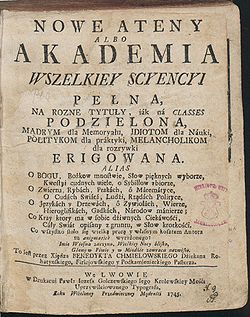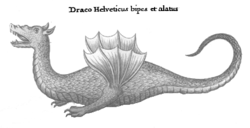
Nowe Ateny
Encyclopedia


Polish language
Polish is a language of the Lechitic subgroup of West Slavic languages, used throughout Poland and by Polish minorities in other countries...
encyclopedia
Encyclopedia
An encyclopedia is a type of reference work, a compendium holding a summary of information from either all branches of knowledge or a particular branch of knowledge....
, authored by the 18th century Polish
Poland
Poland , officially the Republic of Poland , is a country in Central Europe bordered by Germany to the west; the Czech Republic and Slovakia to the south; Ukraine, Belarus and Lithuania to the east; and the Baltic Sea and Kaliningrad Oblast, a Russian exclave, to the north...
priest Benedykt Joachim Chmielowski
Benedykt Chmielowski
Benedykt Joachim Chmielowski was a Polish priest born in Łuck.He wrote Nowe Ateny — the first Polish-language encyclopedia. It was first published in 1745-46; the second edition was supplemented between 1754 and 1764....
. The first edition was published in 1745-1746 in Lwów (Lviv
Lviv
Lviv is a city in western Ukraine. The city is regarded as one of the main cultural centres of today's Ukraine and historically has also been a major Polish and Jewish cultural center, as Poles and Jews were the two main ethnicities of the city until the outbreak of World War II and the following...
); the second edition, updated and expanded, in 1754-1764.
The first part of the full title was: New Athens or the Academy full of all science, divided into subjects and classes, for the wise ones to record, for the idiots to learn, for the politicians to practice, for the melancholics to entertain...
(pl:Nowe Ateny albo Akademia wszelkiej sciencyi pełna, na różne tytuły jak na classes podzielona, mądrym dla memoryału, idiotom dla nauki, politykom dla praktyki, melancholikom dla rozrywki erigowana...).
Organization and content
The first edition of the encyclopedia contains 938 pages. It has a subject (not alphabetic) organization. Chmielowski compiled data from a few hundred references, dating from the Antiquity to his contemporary.Almost every sentence in the book is in-line referenced, frequently in Latin
Latin
Latin is an Italic language originally spoken in Latium and Ancient Rome. It, along with most European languages, is a descendant of the ancient Proto-Indo-European language. Although it is considered a dead language, a number of scholars and members of the Christian clergy speak it fluently, and...
, a lingua franca
Lingua franca
A lingua franca is a language systematically used to make communication possible between people not sharing a mother tongue, in particular when it is a third language, distinct from both mother tongues.-Characteristics:"Lingua franca" is a functionally defined term, independent of the linguistic...
in Poland among the educated classes as in most of Central
Central Europe
Central Europe or alternatively Middle Europe is a region of the European continent lying between the variously defined areas of Eastern and Western Europe...
and Western Europe
Western Europe
Western Europe is a loose term for the collection of countries in the western most region of the European continents, though this definition is context-dependent and carries cultural and political connotations. One definition describes Western Europe as a geographic entity—the region lying in the...
of the 18th century. To the data from the more than a hundred original authors, Chmielowski added personal annotations, some of which can be perceived as colorful today, for example, "Dragons existed for sure, I myself held, visiting Radziwill
Radziwill
The Radziwiłł family is an noble family of Lithuanian origin. The descendants of Kristinas Astikas, a close associate of the 14th century Lithuanian ruler Vytautas, were highly prominent for centuries, first in the Grand Duchy of Lithuania, later in the Polish-Lithuanian Commonwealth and the...
s' castle, a rib of a dragon
Dragon
A dragon is a legendary creature, typically with serpentine or reptilian traits, that feature in the myths of many cultures. There are two distinct cultural traditions of dragons: the European dragon, derived from European folk traditions and ultimately related to Greek and Middle Eastern...
bigger than a regular sabre
Sabre
The sabre or saber is a kind of backsword that usually has a curved, single-edged blade and a rather large hand guard, covering the knuckles of the hand as well as the thumb and forefinger...
". Judging from the inclusion of numerous stories, anecdotes, and description of strange phenomena and exotic countries (like China, Japan), the encyclopedia was directed towards a rather popular audience and aimed to arise readers curiosity and desire for learning.
Legacy
The encyclopedia was the object of harsh critique in the Enlightenment periodAge of Enlightenment
The Age of Enlightenment was an elite cultural movement of intellectuals in 18th century Europe that sought to mobilize the power of reason in order to reform society and advance knowledge. It promoted intellectual interchange and opposed intolerance and abuses in church and state...
. It was given as an example of ignorance, stupidity and superstition, contrasting with the enlightenment ideas.
Nowe Ateny is the source of a few memorable and amusing "definitions", often quoted in Poland to this day:
- Horse is as everyone can see.
- Goats are a stinking kind of animal.
The humor was apparently unintentional by the author. Rather, he did not see the benefit of defining to his intended audience the most common animals of the time and place.
In modern Polish, the above definition of the horse is sometimes used as a colorful equivalent of the statement "the concept is more obvious than it appears to be from its more technical definition".

